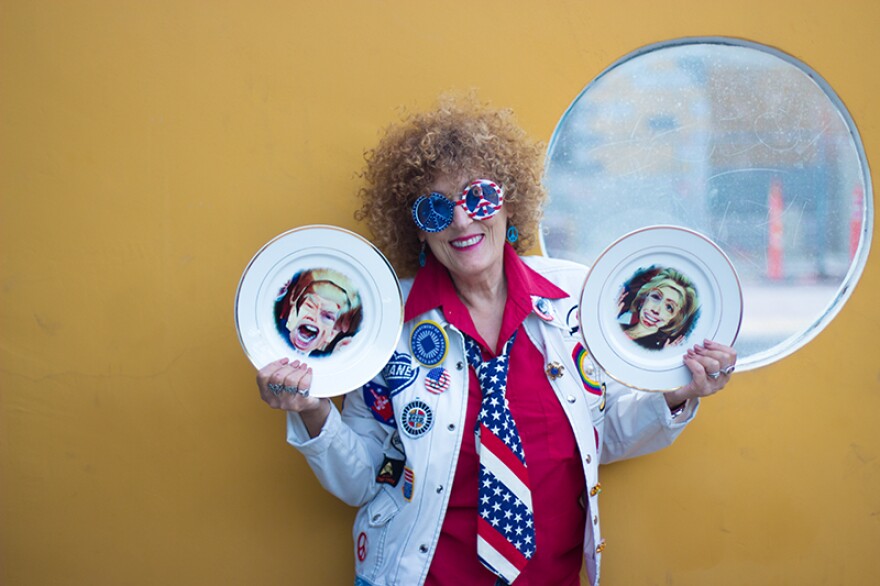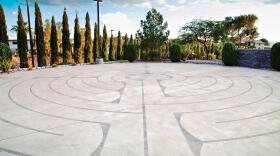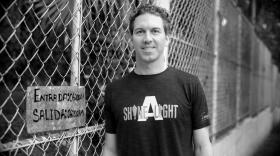It’s over!
Artist Diane Bush marks the end of the campaign — and her political-satire project — with an election bash
As this historically raucous, farcical, apocalyptic, choose-your-own-adjective election shambles to its end, there’s only one place the art-minded will want to be when the polls close: at the Victor Xiu Gallery in Art Square for Diane Bush’s exhibit/event The Final Tally. They’ll find satirical artwork, plenty of Mexican food, screens on which to watch the returns and nearby bars in which to celebrate or mourn the results.
The Final Tally completes Bush’s ambitious 10-month series of exhibits and performances presented under the title Dishing It Out. Dishing It Out featured such components as Mug Shots (mugs decorated with satirical images by local and national artists), Vanity Plates (ditto with plates), Make America Break Again (which involved viewers smashing dishware) and voter registration.
Was there one event or thought that made you undertake such a big project?
Every eight years I turn my attention to the presidential election because folks get too wound up and need a bit of humor and stress-relieving activity. Hence the smashing of plates. There are two reasons that I built this project to span the election season. First was the intricate and complex scope of the project. Second was the fact that as a female artist over 60, I felt like the invisible “old shoe” of the arts community. Without a monthly reminder that I exist, and that I still have some usefulness, I don’t think anyone would know I am an artist. ... My style is to go positive. If taking the higher road does not bring fame and fortune, I’m perfectly fine with that.
Clearly you view art as a vehicle for political expression. How do you maintain the line between art and propaganda?
Was “Guernica” by Picasso propaganda? I think of propaganda as a lie that the powerful repeat. Are artists powerful? Some are, like Ai WeiWei, who has the pleasure of being locked up for making powerful art. One of the project’s goals was to celebrate free speech, and we did that. One of the candidates wants to change the libel laws ... so we shall see how much freedom artists will have in the future.
Now that the end is in sight for both election and project, how are you feeling?
I think it was a success. Folks laughed and had fun, others were inspired, we sold a few pieces and I learned about the dye-sublimation process, all while registering new voters, celebrating free speech, raising some money for art education and retaining my marriage! Artists who had never dabbled in political satire gave it their all, and The Huffington Post published work from eight of our artists.
My goal was a flattering national story about art in Las Vegas. In January, Afterimage Magazine is publishing a feature about my work and this project. To quote George W. Bush, “Mission accomplished!”
Scott Dickensheets
Things have changed
Photographer Richard Brian chronicles the evolving face of Fremont East
BEFORE AND AFTER Along with hungover tourists and Goodmans in the mayor’s office, change is the one of the few constants in Las Vegas, especially in Downtown, most especially on East Fremont. You’ve seen the trailer for Dr. Strange, right? The way an entire cityscape is folded and remade through the awesome power of mystical hogwash? Sorta the same on East Fremont, only here it’s accomplished through the decidedly less mystical, but not entirely hogwash-free process of development. Las Vegas photographer Richard Brian has been documenting this unceasing change. Having snapped elements of the East Fremont streetscape nearly a decade ago, he’s been going back to shoot from the same vantage points. “I was living Downtown before all that happened,” he says. “My stomping grounds were changing so rapidly, I felt I had to preserve that.” His pictures pose an implied question: How fast can a neighborhood change and still have a genuine civic character? Since he intends to keep shooting, perhaps the next round of images will provide an answer.
Five things you didn’t know about Howard Hughes’ Vegas years
Fifty years ago this month, Howard Hughes moved to Las Vegas, parked himself in a penthouse at the Desert Inn and didn’t leave it for four years. From 1966-70, he invested more than $200 million in Nevada casinos, real estate, airports and a television station. Here are five things you didn’t know about that period:
1. When Hughes purchased the Desert Inn for $13.2 million in 1967, he didn’t acquire the land or buildings. He simply bought the rights to operate the hotel-casino and leased the property from Moe Dalitz and his partners for $1.1 million a year. Pretty sweet deal for the Cleveland racketeers.
2. Jimmy “The Greek” Snyder, the celebrity sports bettor and TV commentator, worked as a public-relations consultant for Hughes. Snyder spent most of his time raising awareness about the health dangers of nuclear testing. Hughes tried, unsuccessfully, to stop the radiation-spewing tests 60 miles north of Las Vegas.
3. In 1968, Hughes announced plans for a massive addition to his recently acquired Sands hotel. The resort, Hughes proclaimed, would have a long list of amenities. He was prescient in planning for a bowling alley and a movie theater, which have become de rigueur in Las Vegas resorts. But he was downright bizarre when he boasted of separate rooms for chess, bridge, table tennis and — no joke — skee ball.
4. Although not much of a philanthropist, Hughes did make financial commitments that jump-started development of a medical school and a community college system in Nevada. Without those cash infusions, it’s unlikely either institution would have gotten off the ground until years later.
5. He wasn’t able to buy everything he coveted. The owner of the Review-Journal turned him down. The U.S. attorney general, citing antitrust concerns, derailed his bid to buy the Stardust. And he failed to stop Kirk Kerkorian from building the International Hotel.
Geoff Schumacher















